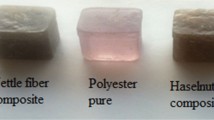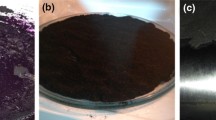Abstract
Tire production shows a high annual growth followed by approximately the same increase in waste generation. Because used tires present an insignificant degree of natural degradation, having high strength, elasticity and long life time, a series of new technologies for tire waste processing were developed. A new method may consist of the using of tires as raw materials in the obtaining of composites for house and industrial applications. Such composites may be obtained from rubber powder of tires, fabrics from used textiles and rubber solutions. These composites can be characterized in terms of thermal characteristics with the aid of thermogravimetric analysis (TGA) connected with simultaneous FT-IR/MS analysis and with dielectric relaxation spectroscopy. With Netzsch “Thermokinetics-3” software it was demonstrated that the thermal degradation is complicated and takes place in several stages. Through FT-IR and MS analysis of the products released during thermal degradation it has been established that the main gases are CO, CO2, methane, ethane, ethene, propane propene, butane, butene, C5 fractions, unsaturated and higher saturated hydrocarbons and aromatic products.









Similar content being viewed by others
References
Machin EB, Pedroso DT, Carvalho JA Jr. Energetic valorization of waste tyres. Renew Sustain Energy Rev. 2017;68:306–15. https://doi.org/10.1016/j.rser.2016.09.110.
https://www.wbcsd.org/Sector-Projects/Tire-Industry-Project/End-of-Life-Tires-ELTs. Accessed 15 Apr 2022.
Martınez JD, Puy N, Murillo R, Garcıa T, Navarro MV, Mastral AM. Waste tyre pyrolysis–a review. Renew Sustain Energy Rev. 2013;23:179–213. https://doi.org/10.1016/j.rser.2013.02.038.
Sienkiewicz M, Kucinska-Lipka J, Janik H, Balas A. Progress in used tyres management in the European Union: a review. Waste Manag. 2012;32:1742–51. https://doi.org/10.1016/j.wasman.2012.05.010.
Shah J, Jan MR, Mabood F, Shahid M. Conversion of waste tyres into carbon black and their utilization as adsorbent. J Chin Chem Soc Taip. 2006;53:1085–9. https://doi.org/10.1002/jccs.200600144.
Saleh TA, Gupta VK. Processing methods, characteristics and adsorption behavior of tire derived carbons: a review. Adv Colloid Interface. 2014;211:93–101. https://doi.org/10.1016/j.cis.2014.06.006.
Quek A, Balasubramanian R. Liquefaction of waste tires by pyrolysis for oil and chemicals: a review. J Anal Appl Pyrolysis. 2013;101:1–16. https://doi.org/10.1016/j.jaap.2013.02.016.
Wang WC, Bai CJ, Lin CT, Prakash S. Alternative fuel produced from thermal pyrolysis of waste tires and its use in a DI diesel engine. Appl Therm Eng. 2016;93:330–8. https://doi.org/10.1016/j.applthermaleng.2015.09.056.
Williams PT. Pyrolysis of waste tyres: a review. Waste Manag. 2013;33:1714–28. https://doi.org/10.1016/j.wasman.2013.05.003.
Sharma VK, Fortuna F, Mincarini M, Berillo M, Cornacchia G. Disposal of waste tyres for energy recovery and safe environment. Appl Energy. 2000;65:381–94. https://doi.org/10.1016/S0306-2619(99)00085-9.
Barlaz MA, Eleazer WE II, Whittle DJ. Potential to use waste tires as supplemental fuel in pulp and paper mill boilers, cement kilns and in road pavement. Waste Manag Res. 1993;11(6):463–80.
Conesa JA, Galvez A, Mateos F, Martın-Gullon I, Font R. Organic and inorganic pollutants from cement kiln stack feeding alternative fuels. J Hazard Mater. 2008;158:585–92. https://doi.org/10.1016/j.jhazmat.2008.01.116.
Lin S-Y. An overview of advanced hyphenated techniques for simultaneous analysis and characterization of polymeric materials. Crit Rev Solid State. 2016;41:482–530. https://doi.org/10.1080/10408436.2016.1186598.
Rajkumar T, Vijayakumar CT, Sivasamy P, Sreedhar B, Wilkie CA. Thermal degradation studies on PMMA–HET acid based oligoesters blends. J Therm Anal Calorim. 2010;100:651–60. https://doi.org/10.1007/s10973-009-0266-2.
Yan Y-W, Huang J-Q, Guan Y-H, Shang K, Jian R-K, Wang Y-Z. Flame retardance and thermal degradation mechanism of polystyrene modified with aluminum hypophosphite. Polym Degrad Stab. 2014;99:35–42. https://doi.org/10.1016/j.polymdegradstab.2013.12.014.
Worzakowska M. TG/FTIR/QMS studies of long chain esters of geraniol. J Anal Appl Pyrolysis. 2014;110:181–93. https://doi.org/10.1016/j.jaap.2014.09.002.
Collard F-X, Blin J. A review on pyrolysis of biomass constituents: mechanisms and composition of the products obtained from the conversion of cellulose, hemicelluloses and lignin. Renew Sustain Energy Rev. 2014;38:594–608. https://doi.org/10.1016/j.rser.2014.06.013.
Du Y, Ju T, Meng Y, Han S, Jiang J. Pyrolysis characteristics of excavated waste and generation mechanism of gas products. J Clean Prod. 2022;370:133489. https://doi.org/10.1016/j.jclepro.2022.133489.
Benhammada A, Trache D. Thermal decomposition of energetic materials using TG-FTIR and TG-MS: a state-of-the-art review. Appl Spectrosc Rev. 2020;55(8):724–77. https://doi.org/10.1080/05704928.2019.1679825.
Ramírez Arias AM, Moreno-Piraján JC, Giraldo L. Kinetic study of waste tire pyrolysis using thermogravimetric analysis. ACS Omega. 2022;7(19):16298–305. https://doi.org/10.1021/acsomega.1c06345.
Singh RK, Ruj B, Jana A, Mondal S, Jana B, Sadhukhan AK, Gupta P. Pyrolysis of three different categories of automotive tyre wastes: product yield analysis and characterization. J Anal Appl Pyrolysis. 2018;135:379–89. https://doi.org/10.1016/j.jaap.2018.08.011.
Risoluti R, Gullifa G, Barone L, Papa E, Materazzi S. On-line thermally induced evolved gas analysis: an update. Part 1: EGA-MS. Molecules. 2022;27(11):3518. https://doi.org/10.3390/molecules27113518.
Yang B, Chen M. Py–FTIR–GC/MS analysis of volatile products of automobile shredder residue pyrolysis. Polymers. 2020;12(11):2734. https://doi.org/10.3390/polym12112734.
ASTM D854 – 14: Standard test methods for specific gravity of soil solids by water pycnometer
ASTM D2240-00: Standard test method for rubber property-durometer hardness
Eckelman CA. Wood moisture calculation. In: Forestry and natural resources, Furniture manufacturing. FNR-156, Purdue University, Department of Forestry & Natural Resources, West Lafayette, IN, USA.
Netzsch “Thermokinetics-3”, version 2008.05.
Friedman HL. Kinetics of thermal degradation of char-forming plastics from thermogravimetry. Application to a phenolic plastic. J Polym Sci. 1964;C6:183–95.
Ozawa TA. A new method of analyzing thermogravimetric data. Bull Chem Soc Jpn. 1965;38:1881–6.
Flynn JH, Wall LA. General treatment of the thermogravimetry of polymers. J Res Natl Bur Stand. 1966;70A:487–523.
Worzakowska M. The kinetic study of the curing reaction of mono- and di-epoxides obtained during the reaction of divinylbenzene and hydrogen peroxide with acid anhydrides. Polymer. 2007;48(4):1148–54. https://doi.org/10.1016/j.polymer.2006.12.020.
Edelmann M, Gedan-Smolka M, Heinrich G, Lehmann D. Thermokinetic analysis of two-step curing reactions in melt Part I. Investigation of low molecular model systems. Thermochim Acta. 2007;452(1):59–64. https://doi.org/10.1016/j.tca.2006.10.006.
Singh T, Sharma C, Singh V, Mukherjee N. Studies on the thermal stability and kinetic parameters of naturally aged Octol formulation. J Therm Anal Calorim. 2021;145:411–21. https://doi.org/10.1007/s10973-020-09750-4.
Zhu FL, Li X, Feng Q. Thermal decomposed behavior and kinetic study for untreated and flame retardant treated regenerated cellulose fibers using thermogravimetric analysis. J Therm Anal Calorim. 2021;145:423–35. https://doi.org/10.1007/s10973-020-09780-y.
Shahcheraghi SH, Khayati GR, Ranjbar M. An advanced reaction model determination methodology in solid state kinetics based on Arrhenius parameters variation. Part I. Thermal dehydration kinetic analysis of Cu4SO4(OH)6. J Therm Anal Calorim. 2015;122:175–88. https://doi.org/10.1007/s10973-015-4708-8.
Aouf C, Nouailhas H, Fache M, Caillol S, Boutevin B, Fulcrand H. Multi-functionalization of gallic acid. Synthesis of a novel bio–based epoxy resin. Eur Polym J. 2013;49:1185–95. https://doi.org/10.1016/j.eurpolymj.2012.11.025.
Mustata F, Tudorachi N, Asandulesa M, Bicu I. Thermal and electrical behavior of hybrid thermosets based on epoxy and maleimide resins cured with p-aminobenzoic acid. Int J Chem Kinet. 2019;51(10):799–814. https://doi.org/10.1002/kin.21310.
Rosu D, Mustata F, Tudorachi N, Musteata VE, Rosu L, Varganici C-D. Novel bio-based flexible epoxy resin from diglycidyl ether of bisphenol A cured with castor oil maleate. RSC Adv. 2015;5(57):45679–87. https://doi.org/10.1039/C5RA05610A.
Nallasamy P, Mohan S. Vibrational spectra of cis-1.4-polyisoprene. Arab J Sci Eng. 2004;29(1A):17–26.
Mustata FR, Tudorachi N, Bicu I. Biobased epoxy matrix from diglycidylether of bisphenol A and epoxidized corn oil, crosslinked with Diels-Alder adduct of levopimaric acid with acrylic acid. Ind Eng Chem Res. 2013;52(48):17099–110. https://doi.org/10.1021/ie402221n.
Mui ELK, Lee VKC, Cheung WH, McKay G. Kinetic modeling of waste tire carbonization. Energy Fuel. 2008;22(3):1650–7. https://doi.org/10.1021/ef700601g.
Mustata F, Tudorachi N. Curing kinetics and thermal characterization of epoxy resin cured with amidodicarboxylic acids. Appl Therm Eng. 2017;125:285–96. https://doi.org/10.1016/j.applthermaleng.2017.07.037.
Jiang B, Hao J, Wang W, Jiang L, Cai X. Synthesis and properties of novel polybismaleimide oligomers. Eur Polym J. 2001;37(3):463–70. https://doi.org/10.1016/S0014-3057(00)00147-6.
Chetehouna K, Belayachi N, Rengel B, Hoxha D, Gillard P. Investigation on the thermal degradation and kinetic parameters of innovative insulation materials using TGA-MS. Appl Therm Eng. 2015;81:177–84. https://doi.org/10.1016/j.applthermaleng.2015.02.037.
Tadini P, Grange N, Chetehouna K, Gascoin N, Senave S, Reynaud I. Thermal degradation analysis of innovative PEKK-based carbon composites for high-temperature aeronautical components. Aerosp Sci Technol. 2017;65:106–16. https://doi.org/10.1016/j.ast.2017.02.011.
Silverstein RM, Webster FX, Kiemle DJ. Spectrometric identification of organic compounds. Hoboken: Wiley & Sons Inc; 2005.
Mustata F, St C, Tudorachi N, Mustata A, Mustata F. Physical and thermal characterization of some cellulose fabrics as reinforced materials for composite. J Therm Anal Calorim. 2015;120:1703–14. https://doi.org/10.1007/s10973-015-4521-4.
Samet M, Levchenko V, Boiteux G, Seytre G, Kallel A, Serghei A. Electrode polarization vs. Maxwell-Wagner-Sillars interfacial polarization in dielectric spectra of materials: characteristic frequencies, and scaling laws. J Chem Phys. 2015;142(19):194703. https://doi.org/10.1063/1.4919877.
Asandulesa M, Kostromin S, Podshivalov A, Tameev A, Bronnikov S. Relaxation processes in a polymer composite for bulk heterojunction: a dielectric spectroscopy study. Polymer. 2020;203:122785. https://doi.org/10.1016/j.polymer.2020.122785.
Larsson O, Said E, Berggren M, Crispin X. Insulator polarization mechanisms in polyelectrolyte-gated organic field-effect transistors. Adv Funct Mater. 2009;19(20):3334–41. https://doi.org/10.1002/adfm.200900588.
Asandulesa M, Kostromin S, Tameev A, Aleksandrov A, Bronnikov S. Molecular dynamics and conductivity of a PTB7:PC71BM photovoltaic polymer blend: a dielectric spectroscopy study. ACS Appl Polym Mater. 2021;3(10):4869–78. https://doi.org/10.1021/acsapm.1c00610.
Acknowledgements
Access to the research infrastructure developed through the European Social Fund for Regional Development, Competitiveness Operational Programme Axis 1, Action: 1.1.3, Project “Infra SupraChem Lab–Center for Advanced Research in Supramolecular Chemistry” (Contract 339/390015/25.02.2021, cod MySMIS: 108983) is gratefully acknowledged.
Author information
Authors and Affiliations
Contributions
All the authors contributed equally to accomplishing the work.
Corresponding author
Additional information
Publisher's Note
Springer Nature remains neutral with regard to jurisdictional claims in published maps and institutional affiliations.
Rights and permissions
Springer Nature or its licensor (e.g. a society or other partner) holds exclusive rights to this article under a publishing agreement with the author(s) or other rightsholder(s); author self-archiving of the accepted manuscript version of this article is solely governed by the terms of such publishing agreement and applicable law.
About this article
Cite this article
Mustata, F.S.C., Asandulesa, M., Varganici, C. et al. Composites based on cotton fabrics, acrylic rubber and powder from used tires: thermal and electrical characterization. J Therm Anal Calorim 148, 3325–3339 (2023). https://doi.org/10.1007/s10973-022-11928-x
Received:
Accepted:
Published:
Issue Date:
DOI: https://doi.org/10.1007/s10973-022-11928-x




